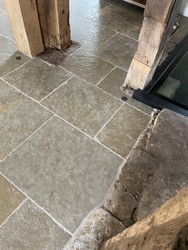The Art of Tiling with Natural Stone: Beauty, Durability, and Timeless Elegance
Posted by Pure Adhesion Ltd on 14th Mar 2025
Natural stone has been used for centuries to create stunning architectural masterpieces, from ancient Greek temples to grand Italian villas. Today, this exquisite material remains a top choice for homeowners and designers looking to infuse spaces with elegance, durability, and a touch of nature. Whether you're considering marble, granite, slate, travertine, or limestone, tiling with natural stone can transform any space into a luxurious retreat. However, working with natural stone requires careful planning, proper installation techniques, and ongoing maintenance to preserve its beauty.
Why Choose Natural Stone?
Natural stone offers unique textures, colors, and patterns that synthetic materials simply can't replicate. Each tile is one-of-a-kind, shaped by millennia of geological processes, ensuring that no two installations are ever the same. Aside from aesthetics, natural stone is incredibly durable and long-lasting, making it an excellent investment for flooring, walls, countertops, and even outdoor spaces.
Selecting the Right Stone for Your Project
Different types of natural stone have distinct characteristics, making them suitable for various applications:
- Marble: Renowned for its luxurious appearance and veining, marble is ideal for elegant interiors but requires sealing to prevent staining.
- Granite: Extremely durable and resistant to heat and scratches, granite is a perfect choice for kitchen countertops and high-traffic areas.
- Slate: With its natural cleft surface and rich earthy tones, slate is excellent for rustic designs and outdoor applications.
- Travertine: A classic choice for warm, Mediterranean-style designs, travertine is versatile but requires sealing due to its porous nature.
- Limestone: Soft and sophisticated, limestone is best suited for indoor flooring and wall applications.
Installation Tips for Natural Stone Tiles
Proper installation is crucial to ensure the longevity and performance of natural stone tiles. Here are some key tips:
- Surface Preparation: Ensure the surface is clean, level, and free from moisture to prevent issues with adhesion and cracking.
- Choosing the Right Adhesive: Use a thin-set mortar specifically designed for natural stone, as it provides better bonding and flexibility.
- Sealing the Stone: Many natural stones are porous and require sealing before and after installation to protect against stains and moisture penetration.
- Grouting Techniques: Using the right grout color enhances the overall look. Non-sanded grout is recommended for softer stones to prevent scratching.
- Expansion Joints: Allow for natural movement by incorporating expansion joints, especially in large areas and exterior installations.
Maintaining Natural Stone Tiles
To keep natural stone looking pristine, follow these maintenance tips:
- Regular Cleaning: Use a pH-neutral cleaner specifically designed for natural stone to avoid damage.
- Resealing: Depending on the type of stone and usage, resealing may be required every six months to a few years.
- Avoid Harsh Chemicals: Acidic substances like vinegar and lemon juice can etch the surface of marble and limestone.
- Use Mats and Rugs: In high-traffic areas, placing mats or rugs can help prevent wear and tear.
Conclusion
Tiling with natural stone is an investment in timeless beauty and durability. With the right selection, careful installation, and proper maintenance, natural stone tiles can enhance your home for generations to come. Whether you're looking to create a modern, rustic, or classical design, the natural charm and elegance of stone make it a perfect choice for any space.


